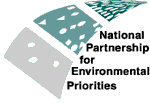Partnerships
Forming Partnerships to Meet the Challenge
EPA has established a variety of targeted partnerships to meet the Resource Conservation Challenge. We are establishing and expanding many partnerships with business and organizations, industries, States and local governments, tribes, and other entities to effectively manage materials and to reduce waste. These partnerships are providing smarter, faster ways to safeguard our environment.
To learn more about becoming a partner, see Guide to Becoming a Resource Conservation Challenge Partner. Select EPA Partnerships are described below.

The Coal Combustion Products Partnership (C2P2) is a cooperative effort between EPA, the coal combustion products (CCP) industry, and partners to help promote the beneficial use of CCPs and the associated environmental, economic, and performance benefits. Through the C2P2 Program, EPA and its co-sponsors—the American Coal Ash Association and the Utility Solid Waste Activities Group—are working with industry organizations and agencies at both the Federal and State levels to reduce or eliminate legal, institutional, economic, market, informational, and other barriers to the beneficial use of CCPs.
GreenScapes provides cost-efficient and environmentally friendly solutions for large-scale landscaping. Designed to help preserve natural resources and prevent waste and pollution, the GreenScapes Partnership Program encourages companies, government agencies, and other entities to make more holistic decisions regarding waste generation and disposal, and highlights the associated impacts on land, water, air, and energy use.

The National Partnership for Environmental Priorities (NPEP), formerly the National Waste Minimization Partnership Program (NWMPP), encourages public and private organizations to form voluntary partnerships with EPA that reduce the use or release of priority chemicals (PCs). Organizations choose one or more facility processes that use the priority chemical(s) and that have reduction potential. Working with purchasing, operations, sales, environmental management, and maintenance departments to identify possible source reduction, recycling and/or recovery opportunities, partners establish a goal and a project timeline for each of the chemicals identified.
Plug-In To eCycling aims to increase the safe recycling of consumer electronics by providing information and guidance; increasing recycling opportunities; facilitating partnerships with communities, electronics manufacturers, and retailers to promote shared responsibility for safe electronics recycling; and establishing pilot projects to test innovative approaches to safe electronics recycling.

Product Stewardship Partnerships involve efforts to reduce the life-cycle impacts of products through voluntary product stewardship partnerships with manufacturers, retailers, governments, and non-government organizations. An example of this is Carpet America, ![]() an industry-led, multi-stakeholder organization that seeks to divert 40% of carpet from landfills by 2012 through recycling, reuse, and other waste recovery and waste minimization activities.
an industry-led, multi-stakeholder organization that seeks to divert 40% of carpet from landfills by 2012 through recycling, reuse, and other waste recovery and waste minimization activities.
 The Schools Chemical Cleanout Campaign (SC3) aims to ensure that all schools are free from hazards associated with mismanaged chemicals. SC3 gives K-12 schools information and tools to responsibly manage chemicals. By using the tools provided on the SC3 site and pulling together a team with a variety of perspectives, expertise, and resources you can develop a successful chemical management program. Schools, parents, and local organizations can partner to create a chemical management program that meets the unique needs of their schools.
The Schools Chemical Cleanout Campaign (SC3) aims to ensure that all schools are free from hazards associated with mismanaged chemicals. SC3 gives K-12 schools information and tools to responsibly manage chemicals. By using the tools provided on the SC3 site and pulling together a team with a variety of perspectives, expertise, and resources you can develop a successful chemical management program. Schools, parents, and local organizations can partner to create a chemical management program that meets the unique needs of their schools.
 WasteWise is a successful partnership program that seeks to reduce municipal solid waste through innovative waste prevention and recycling techniques. More than 1200 business, government, and institutional partners have reported a reduction of 35 million tons of municipal solid waste. Our WasteWise Partners continue to take on new challenges, such as encouraging the reuse and recycling of construction and demolition debris and the use of recycled products to create new "WasteWise buildings."
WasteWise is a successful partnership program that seeks to reduce municipal solid waste through innovative waste prevention and recycling techniques. More than 1200 business, government, and institutional partners have reported a reduction of 35 million tons of municipal solid waste. Our WasteWise Partners continue to take on new challenges, such as encouraging the reuse and recycling of construction and demolition debris and the use of recycled products to create new "WasteWise buildings."
Other Links of Interest:
- Partners for the Environment - Provides alphabetical and subject lists with descriptions of EPA's voluntary partnership programs.
- Compliance Assistance Centers
 - Details EPA-sponsored partnerships with industry, academic institutions, environmental groups, and other agencies to launch sector-specific Compliance Assistance Centers. Each Center addresses real world issues in language that speaks to the regulated entities. Through the Internet, telephone assistance lines, fax-back systems, and e-mail discussion groups, the centers are helping businesses, local governments, and federal facilities understand federal environmental requirements and save money through pollution prevention techniques.
- Details EPA-sponsored partnerships with industry, academic institutions, environmental groups, and other agencies to launch sector-specific Compliance Assistance Centers. Each Center addresses real world issues in language that speaks to the regulated entities. Through the Internet, telephone assistance lines, fax-back systems, and e-mail discussion groups, the centers are helping businesses, local governments, and federal facilities understand federal environmental requirements and save money through pollution prevention techniques. - Design for the Environment -
The Design for the Environment program helps businesses incorporate environmental
considerations into the design of products by integrating cleaner, cheaper, and smarter solutions into everyday business practices. - ENERGY STAR - Provides businesses and consumers with energy efficient strategies and solutions for facilities and products that save money while protecting the environment for future generations.
- Hospitals for a Healthy Environment
 - Describes the partnership between EPA and the American Hospital Association to advance pollution prevention efforts in our nation's health care facilities by providing health care professionals the tools and information necessary to reduce mercury waste, reduce the overall volume of waste, and identify pollution prevention opportunities.
- Describes the partnership between EPA and the American Hospital Association to advance pollution prevention efforts in our nation's health care facilities by providing health care professionals the tools and information necessary to reduce mercury waste, reduce the overall volume of waste, and identify pollution prevention opportunities. - Industry Sector Performance Program – Offers information about EPA’s voluntary partnership with industry trade associations, states, and other stakeholders to take actions that overcome regulatory and other barriers to performance improvement and to promote sector-wide Environmental Management Systems use.
- National Environmental Performance Track – Details EPA's most comprehensive partnership program—the first multimedia partnership program encouraging companies to continuously reduce their facilities' total effect on the environment.
![[logo] US EPA](https://webarchive.library.unt.edu/eot2008/20081106195238im_/http://www.epa.gov/epafiles/images/logo_epaseal.gif)